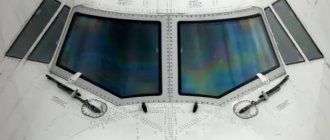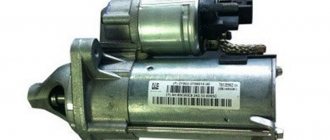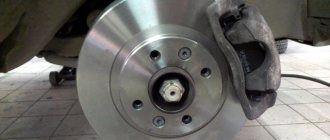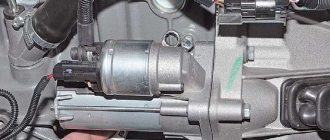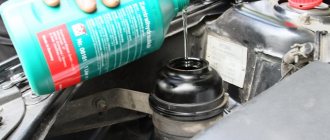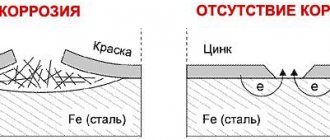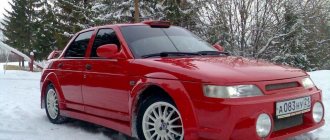AVTOVAZ recommends performing maintenance (MOT) for cars of the Lada Largus family every 15,000 km or every year (whichever comes first). It is also recommended that during the warranty period, maintenance be performed only at an official LADA dealer, with a mandatory note about the work being carried out in the service book coupons. It is worth noting that the maintenance regulations differ depending on the year of manufacture of the car.
List of events 1 maintenance after 15,000 km
- the engine air filter is changed;
- change the oil and oil filter;
- the control system is diagnosed;
- the tightness of the exhaust system, seals and seals of the engine, cooling system, fuel hoses and pipes is checked;
- the clutch and condition of the wheel drives are checked;
- the condition of the hinges and silent blocks of the suspension is checked;
- shock absorbers are checked;
- check the fluid level in the power steering reservoir;
- the covers of the steering system parts are checked;
- check the fuel fluid level in the gas tank;
- brake pads and front wheel discs are checked;
- the technical condition of the battery is checked;
- interior lighting lamps and headlights are checked;
- alarms and combinations of electrical appliances are checked;
- the condition of the side mirrors and windshield is checked;
- windshield and rear window wipers are checked;
- body paintwork is checked;
- the serviceability of the locks is checked.
Electrical equipment
Checking the battery condition++++++++++Checking the interior and exterior lighting lamps++++++++++Checking the operation of the signaling devices and instrument cluster++++++++++List of 10 maintenance events after 150,000 km
- all events from 1 TO;
- spark plugs are changed;
- The air conditioning system is checked and cleaned.
After a mileage of over 150,000 km, maintenance is carried out in the same sequence as in the lists above. When operating a car on dusty roads, you will have to replace the air filter more often.
In addition to the above work, you can perform wheel balancing at intervals of 30,000 km (for even maintenance) after checking the tires and rims. You should also clean and lubricate the terminals and clamps of the battery, and check that it is securely fastened.
TO-2
During the second maintenance, the list of routine repair operations expands. In addition to the indicated replacement of engine lubricant, owners will be faced with the need to change the spark plugs in the ignition system and the filter element of the air intake tract. Cars equipped with an air conditioning system will have this circuit cleaned and the system diagnosed. This allows for efficient operation of the air conditioning system in order to maintain a favorable climate inside the cabin. To perform the second maintenance, a Lada Largus car must “run” 30 thousand km or exist with the owner for 2 years. An error of 500 km is also relevant here.
Here the repair list can be expanded by involving additional activities not provided for by the regulations. Even if the brake pads are replaced during initial maintenance, during the second scheduled maintenance 2 and 3, it can be almost 100% certain that this procedure will be repeated due to wear.
Some Lada Largus owners are concerned about the condition of the CV joint boots. The covers are replaced, and the hinge mechanism is filled with new lubricant.
Sometimes there are problems with uneven distribution of braking force in the system of the same name. With such a malfunction, the car tends to spontaneously move to the side while moving. This is also where service mechanics come to the rescue. The price level of TO 2 and 3 is slightly higher. TO 2 cost 3.5 – 3.8 thousand rubles.
Approximate issue price
For drivers' information, let's do a little calculation of how much maintenance will cost, at least approximately. The first maintenance, as already mentioned, is carried out at a mileage of 15,000 km or after 1 year.
Approximate costs will be as follows:
- oil filter – 580 rubles;
- air – 970 rubles;
- dirt-repellent lubricant LIQUI MOLI (0.25l) – 120 rubles;
- gasket with rubber ring - 40 rubles;
- liqui oil – 1155 rubles;
- copper aerosol – 98.10 rubles.
The total is 2963.10 rubles. We must take into account the payment for the work: 2390 rubles. So, the cost of the 1st maintenance will be approximately 5353.10 rubles.
TO-3
At this stage of maintenance, the list, as prescribed by the maintenance regulations, is limited to replacing the lubricant in the engine. This service is carried out after 45 thousand kilometers. Some dealers put forward a proposal to replace the brake pads and spark plugs during TO-3. This circumstance is relevant for this category of owners who applied for the third stage of service in warm weather.
Although the manufacturer has a negative attitude towards “shifts” in the deadlines for completing work, he will not dare to deprive the owner of the warranty. Here it is recommended to insist on completing the entire list of routine maintenance and within the time frames approved directly by the car manufacturer.
Also, during this stage of maintenance, an increase in unexpected breakdowns is possible. If previously the car “suffered” from excessive wear of the brake discs, then this time it will definitely not be possible without replacement.
There may be a situation with a malfunction of the oil circuit in the engine. This manifests itself in the form of fluid leaks through the shaft seals. This problem must be addressed immediately during the maintenance phase.
There is a high probability of door sensor failures. Here the dealer agrees to repair the damage under warranty, but may accuse the owner of causing damage to this unit by jamming a large object between the door card and the body panel.
The price for TO-3 is identical to the cost of primary service, that is, 2.4 - 2.5 thousand rubles, but TO 2 costs more.
Features of the LADA Largus maintenance regulations
Car owners of Russian cars do not have high expectations about the quality of local assembly, materials used and consumables in the Lada Largus car series. In this case, most drivers strive to adhere to the repair and diagnostic schedules established by the manufacturer. The frequency of work may even include a zero maintenance cycle, during which the machine undergoes a thorough inspection, tightening of important threaded connections and monitoring of the general condition of basic components, systems and mechanisms.
Further stages of maintenance
They are almost identical to the previously discussed stages, but with their own nuances. The frequency of further maintenance remains at a 15 thousand interval.
Now let us point out the similarity of the subsequent stages with the previous ones, that is, those we previously considered:
- TO-5 is similar in content to TO-1;
- TO-6 is practically no different from TO-2, with the exception of the addition to the regulations for replacing fluids in the brake and cooling circuits; THAT 2 cost is also an important point.
- TO-7 is again identical to TO-1;
- TO-8 does not differ from TO-4, however, a procedure for replacing the timing belt drive is added.
Further, the service book does not contain information about maintenance, but dealer specialists recommend visiting a repair terminal after every 15,000 mileage interval of the LADA Largus. The list of repair work will repeat the contents of the previously completed maintenance stages.
Lada Largus engines - volume, power and price |
The engine, known to everyone from the first Logan, is famous for its simplicity, reliability and low cost of spare parts. But since it is assembled abroad, it soon turned out to be economically unprofitable.
| Type | injector |
| Fuel type | gasoline AI-95 |
| Location | front, transverse |
| Cylinders | 4 in a row |
| valves | 8 |
| Working volume | 1598 cm³ |
| Engine power | 84 hp |
| Torque | 124 Nm |
| Acceleration to 100 | 14.5 s |
| Max. speed | 156 km/h |
| Ecological Class | EURO 4 |
| Consumption city | 10.6 l |
| Flow track | 6.7 l |
| Mixed flow | 8.2 l |
Let's sum it up
Solid mileage does not make the LADA Largus car fresh. At the 100,000th mark, you can detect pockets of corrosion on the thresholds and encounter failures of electronic sensors in many systems, both external components and interior equipment. Also, owners are faced with the need to replace suspension elements, be it shock absorbers or levers, and this is the whole list of work.
At 150 thousand mileage, the camshafts will need to be replaced, and the “number” on the odometer of 200 thousand may necessitate a major overhaul of the LADA Largus engine.
When you buy a new car, you become a participant in the warranty program, which helps eliminate faults that arise due to fault. For domestic cars, the concept of routine maintenance (MOT) and warranty obligations was previously a mere formality, since consumers did not expect superior quality from cheap vehicles, and manufacturers allocated very little money for these programs. However, the emergence of new VAZ models, including the Lada Largus station wagon, and a complete change in the policy of relationships with customers by this manufacturer have led to the fact that routine maintenance has become truly useful for motorists. To understand what awaits the owners of a VAZ station wagon during maintenance, it is worth taking a closer look at the Largus maintenance regulations.
Car owners must monitor the condition of the Lada Largus themselves and carry out diagnostics and maintenance on time
Whose engine is the Lada Largus?
Previously, engines for Lada Largus came assembled from the Renault plant in Spain, but recently engines of the K4M series (16 valves, 105 hp) began to be assembled at AvtoVAZ. According to the director of the Power Units project, Francois Goujon, the quality of engines assembled at AvtoVAZ corresponds to the world level.
The AvtoVAZ press service assures that a quality system is used in the production of new engines to ensure that products comply with the international standards of the alliance. In addition to personnel training, it includes control on the production line, during which each assembled engine is tested in different modes on a special stand. The technology also provides for a weekly check, when one of the motors is completely disassembled and the quality of its assembly is analyzed.
Which engines are better? VAZ or Renault?
Domestic engines are superior to their French predecessors. Cars with VAZ engines accelerate faster, pull better at low speeds, are quieter and have lower fuel consumption.
Both domestic engines installed on the Lada Largus are modifications of older models. They have already stood the test of time and proven their competitiveness. Thanks to the reduction in the cost of engines, AvtoVAZ added to the car's equipment - athermal glass was added, an improved vacuum brake booster, the windshield wiper mechanism was changed, additional sensors appeared, etc. The car became more comfortable, but the price remained the same.
VAZ 11189 and 21129 have an important advantage. Spare parts for them are cheaper than for French engines. All internal combustion engines installed on Largus require careful maintenance and monitoring, but driving a car with a domestic engine is cheaper.
To make the price of spare parts and service even cheaper, order them from Largus Shop with free delivery. We regularly hold promotions and give discounts to regular customers.
Maintenance
Maintenance of the Lada Largus car at our club service.
| Regular maintenance of your vehicle is very important for the vehicle's performance. It is necessary to maintain the technical condition in accordance with the maintenance schedule of the service book in order to ensure better operation and appropriate technical condition of your vehicle, as well as extend the life of the vehicle. Carrying out regular vehicle maintenance also helps to detect and eliminate hidden threats and prevent accidents due to breakdowns in time. This chapter describes in detail the maintenance of technical condition and inspection of the vehicle, so please read it carefully. MAINTENANCE REGULATIONS FOR LADA LARGUS MAINTENANCE
Please carefully follow the rules for using engine oil, fuel, coolant and brake fluid provided in this vehicle operating manual; otherwise, your vehicle may be damaged. INDEPENDENT THAT Constantly check the level of operating fluids and add them as necessary. Check lights, brakes and tire pressure. Check the warning lamps. The reservoirs for brake coolant and power steering are translucent to make it easier to determine the amount of fluid when inspecting the vehicle.
Inflammation must be ruled out before working on the engine compartment. Even when the ignition key is turned off, the cooling fan may continue to operate automatically. Therefore, please avoid getting clothes (ties) caught in the fan or drive belt. GENERAL REQUIREMENTS FOR VEHICLE MAINTENANCE Wash your vehicle only in designated areas to prevent environmental pollution. Used engine oil, brake fluid, coolant, battery and tires should only be disposed of by qualified waste disposal companies or through consultation with the manufacturer, and should not be disposed of as household waste or poured into public drainage systems. Everyone should care about protecting the environment and contribute to it. MAINTENANCE SCHEDULE Daily review: • Working condition of all internal and external lamps. Replace burned out or faded light bulbs to ensure all lenses are clean. Inspection when refueling: • Engine oil level • Brake fluid level • Windshield washer fluid level • Tire pressure and condition (cold only) • Inspect all pipes and crankcase ventilation system to ensure there is no chafing or damage. |
TO-4
This stage of the service involves the most serious list of work. Here, repair procedures similar to the first three stages of maintenance are performed. The replacement will concern:
- candles;
- oils with filter;
- air filter;
- pads;
- drive belt for motor attachments in combination with a roller.
Additionally, the stern drum brake units will be inspected, the air conditioner will be cleaned, and the system will be diagnosed along the way.
Another common problem that worries LADA Largus owners when crossing the 60,000 mileage mark is instability of engine speed in idle mode. This is often resolved through computer intervention in the on-board controller.
A common malfunction is the breakdown of the steering shaft locking device, which is also replaced according to the next maintenance program.
If the owner neglected to adjust the wheel angles, then at such a mileage they may be asked to replace the tires of the wheels. In terms of cost, TO-4 is not much of a leader, since the amounts are quite affordable: 3.5-4.2 thousand rubles.
How to change the oil and oil filter
To unscrew the crankcase plug, you will need a key with 4 edges (10 by 10 mm square). To remove the oil filter, you will need to use a special cup puller. Access to the plug of the 8-valve engine is possible through the slots in the crankcase protection.
If we talk about the 16-valve engine, things will be more complicated here. Having positioned the car on an overpass, you can remove the engine protection by unscrewing 6 bolts. This way you can gain access to the drain hole. If there are no conveniences in the form of an overpass, the fuel rail screen is dismantled. It will not be possible to hook and pull out the oil filter without a cup puller. Service centers do the following: they change the filter, but do not drain the oil, but pump it out using a pneumatic installation. The manufacturer himself recommends doing the same, and we recommend contacting a service center as soon as the odometer readings exceed the next 15 thousand.
This is interesting: Types of fuel additives
